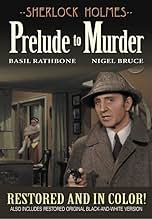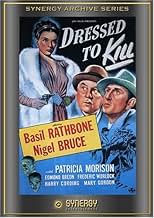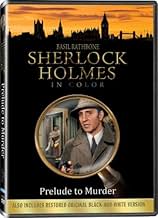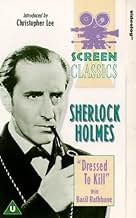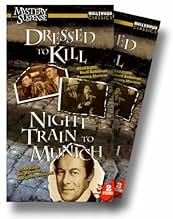IMDb-BEWERTUNG
6,8/10
7355
IHRE BEWERTUNG
Füge eine Handlung in deiner Sprache hinzuA trio of music boxes contains the hidden secret to riches, and a group of criminals will kill for them. In Vibrant Color.A trio of music boxes contains the hidden secret to riches, and a group of criminals will kill for them. In Vibrant Color.A trio of music boxes contains the hidden secret to riches, and a group of criminals will kill for them. In Vibrant Color.
- Regie
- Drehbuch
- Hauptbesetzung
Edmund Breon
- Julian 'Stinky' Emery
- (as Edmond Breon)
Frederick Worlock
- Col. Cavanaugh
- (as Frederic Worlock)
Harry Allen
- Scottish Man at Auction
- (Nicht genannt)
Frank Baker
- Photographer
- (Nicht genannt)
Guy Bellis
- Doctor
- (Nicht genannt)
Wilson Benge
- Minister on Museum Tour
- (Nicht genannt)
Marjorie Bennett
- Antique Shop Assistant
- (Nicht genannt)
Ted Billings
- Pub Patron
- (Nicht genannt)
Empfohlene Bewertungen
A suspenseful Holmes and Watson feature about a group of killers out to find three music boxes sold at an auction. The boxes contain something in them that will help lead the crooks to loads of money. Only problem is that Sherlock Holmes is on their trail. Typical good acting and tight direction help this one rise above its somewhat implausible story. The chemistry between Rathbone and Bruce is as ever the binding of the film. Some other good performances are given by Patricia Morrison as a wicked woman and Edmund Breon as "Stinky," a school chum of Watson's. The verbal banter between Morrison and Holmes is for me the most memorable aspect of the film. As I watched the film, the lines slowly crept back into my head. "Praise from you is indeed gratifying Mr. Holmes," and then a line about respecting his memory. Great stuff!
The last Rathbone Holmes (14/14) is again a slightly weaker affair than most of the preceding entries, another variant of The Pearl of Death this time involving music boxes. Music boxes whose tunes play out the location of the stolen and hidden Bank of England £5 plates no less. Holmes proves he has an inbuilt police whistle and a photographic(?) memory for music, whilst Watson says that he likes brass bands but is tone deaf. The woman here, although a thoroughly bad hat is not The Woman, the one and only Irene Adler who had bested Holmes in 1891, but for most of the film she has the upper hand.
By now the steam had left Rathbone, and although Bruce wanted to carry on and Universal held the copyright until 1949 the series had reached its natural conclusion. Director Roy William Neill had less than a year left to live too. Some lovely bits: Holmes consoling Mrs Hudson, distraught at letting 2 people into 221b who turned it over; Holmes' biscuit jar was seen to good advantage. And yes, the bullet holes in the wall from Faces Death were still there at the end! No matter how bad, mawkish or daft this marvellous series got I've always loved every entry. Watching a clean Definitive DVD of this with a lump in my throat I think of Brian Wilson's line "It's so sad to watch a sweet thing die", without even the dignity of end credits (they're lost).
All things must pass.
By now the steam had left Rathbone, and although Bruce wanted to carry on and Universal held the copyright until 1949 the series had reached its natural conclusion. Director Roy William Neill had less than a year left to live too. Some lovely bits: Holmes consoling Mrs Hudson, distraught at letting 2 people into 221b who turned it over; Holmes' biscuit jar was seen to good advantage. And yes, the bullet holes in the wall from Faces Death were still there at the end! No matter how bad, mawkish or daft this marvellous series got I've always loved every entry. Watching a clean Definitive DVD of this with a lump in my throat I think of Brian Wilson's line "It's so sad to watch a sweet thing die", without even the dignity of end credits (they're lost).
All things must pass.
Sherlock Holmes and the Secret Code isn't quite among the best of the series like Hound of the Baskervilles, Adventures of Sherlock Holmes and Scarlet Claw but it is better than Pursuit to Algiers(my personal least favourite of the series) and Voice of Terror. Neither of them are bad films though, even the weakest have entertainment value, but none are masterpieces nor did they try to be so. The story takes a little too much time to get going, things get more interesting once Holmes arrives on the scene, the film does end rather abruptly and agreed Holmes does make a few dumb and uncharacteristic mistakes here(like with the poorly guarded box). Basil Rathbone is excellent as Holmes as always, distinguished, cunning and authoritative. Nigel Bruce gives his all to Watson, while at times too much of a bumbling idiot he brings some joviality to the proceedings. Patricia Morrison is an elegant and calculating female nemesis too, and the supporting roles are well-taken. Sherlock Holmes and the Secret Code is solidly made and directed, they don't try to be too fancy but neither do they take a cheap route and they do give off a good atmosphere. The music score is appropriately eerie and doesn't overbear the mystery at all, the dialogue is snappy and amusing with a few suspenseful elements and once it gets going the story- with a good if daft idea- is fun with some nice twists and turns. The climax may be somewhat too easy but it's also very exciting, while the Holmes comforting Mrs Hudson and Watson imitating a duck scenes are nice too. All in all, not a high note end to the entertaining Rathbone-Holmes films series but hardly a sour note either. 7/10 Bethany Cox
In their last on-screen outing as Holmes and Watson (they still did radio plays with each other after this movie) Rathbone and Bruce find themselves involved in a music box mystery. It seems that anyone who bought one of three matching boxes from a recent auction ends up either dead or with a nasty bump on the head. Assuming that there must be a weird connection Holmes takes the case.
The story rivals even The Voice of Terror in terms of sheer implausibility. When the purpose of the music box is reveal you have to wonder why anyone would go to all that effort. But it's still entertaining and Patricia Morrison makes for a brilliant villainess.
Producer and Director Roy William Neill died not long after this film was released, which is probably why it ended up being the last. They could have went on a lot longer, especially if they started using some of Conan Doyle's original works (something that they very rarely did, opting for original screenplays instead), although this one does reference two of stories as past cases.
A fine, if unspectacular end of a definitive era.
The story rivals even The Voice of Terror in terms of sheer implausibility. When the purpose of the music box is reveal you have to wonder why anyone would go to all that effort. But it's still entertaining and Patricia Morrison makes for a brilliant villainess.
Producer and Director Roy William Neill died not long after this film was released, which is probably why it ended up being the last. They could have went on a lot longer, especially if they started using some of Conan Doyle's original works (something that they very rarely did, opting for original screenplays instead), although this one does reference two of stories as past cases.
A fine, if unspectacular end of a definitive era.
The last in a wonderful cycle of 14 movies that got launched by a different major production company but always kept the brilliant duo of lead actors Basil Rathbone and Nigel Bruce as Sherlock Holmes and his loyal assistant Dr. Watson. Some say this is a much weaker entry in the series but, quite frankly, I have no idea on what arguments those opinions are based, as this is another marvelously scripted and professionally directed detective adventure! When an old school friend of Dr. Watson is found murdered, Sherlock Holmes immediately suspects that this has something to do with his latest collector's item purchase, namely a wooden musical box. Two other identical boxes were made by a convicted burglar in prison and the altered melody hides a secret code that leads his accomplices to the location of two stolen Bank of England printing plates! True, the valuable-objects-hidden-at-different-locations premise is somewhat similar to the previous Holmes film "The Pearl of Death" and may therefore come across as unoriginal, but the screenplay contains more than enough variety to make "The Secret Code" another very compelling mystery film. Holmes female opponent, for example, is a truly clever woman who nearly succeeds in setting a trap for our brilliant detective during a very well-mounted sequence. Furthermore, "The Secret Code" (I refuse to use the completely irrelevant title "Dressed to Kill") is fast-paced and contains loads of terrific dialogues. As usual, Bruce's character Dr. Watson provides the story with a couple of neat comical moments, most notably the scene in which he tries to comfort a little girl who just got traumatized by imitating the sound of a duck...impressively, I may add.
Wusstest du schon
- WissenswertesThe last of 14 films released from 1939-46 based on Arthur Conan Doyle's fictional consulting detective Sherlock Holmes starring Basil Rathbone as Holmes and Nigel Bruce as Dr. Watson. Rathbone was reportedly tired of playing the character. However, he would play Holmes on the stage, radio and television at various times the rest of his career.
- PatzerDr. Watson is repeatedly described as having "no ear for music". Yet in two previous films of the series, he is seen both singing and playing the tuba.
- Zitate
Colonel Cavanaugh: By now Mr. Holmes has no doubt exchanged his violin for a harp.
Mrs. Hilda Courtney: Oh, well, assuming that Heaven is his destination.
- Crazy CreditsThis movie's final credit sequence rolled over a scene of Basil Rathbone and Nigel Bruce leaving Dr. Johnston's house. This sequence was later removed by a TV distributor and has been replaced with a THE END frame from one of the earlier Sherlock Holmes films.
- Alternative VersionenOriginally, this movie ended with the final credits superimposed over a shot of Holmes and Watson leaving Dr. Johnson's house. This footage was trimmed by TV distributors and is now lost, so the MPI restorers had to tack on a THE END sequence from another film to finish this Sherlock Holmes film.
- VerbindungenFeatured in The Many Faces of Sherlock Holmes (1985)
- SoundtracksThe Swagman
(uncredited)
Australian folk song
Played on a music box several times
Played on piano and on violin by Basil Rathbone and whistled by him
Played on piano by Wallace Scott
Top-Auswahl
Melde dich zum Bewerten an und greife auf die Watchlist für personalisierte Empfehlungen zu.
- How long is Dressed to Kill?Powered by Alexa
Details
- Erscheinungsdatum
- Herkunftsland
- Offizieller Standort
- Sprache
- Auch bekannt als
- Jagd auf Spieldosen
- Drehorte
- Produktionsfirmen
- Weitere beteiligte Unternehmen bei IMDbPro anzeigen
Box Office
- Budget
- 100.000 $ (geschätzt)
- Laufzeit
- 1 Std. 11 Min.(71 min)
- Farbe
- Seitenverhältnis
- 1.33 : 1
Zu dieser Seite beitragen
Bearbeitung vorschlagen oder fehlenden Inhalt hinzufügen


